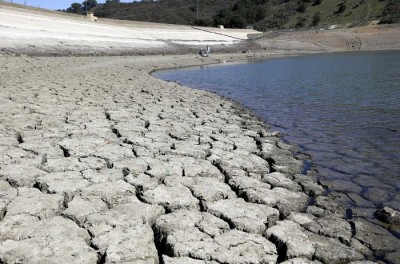Amid Record Drought, Fracking Companies Given Free Pass To Use 70 Million Gallons Of Clean Water

Image source: UCLA.edu
When Governor Jerry Brown ordered average Californians to cut their water use by 25 percent on April 2, he specifically exempted fracking operations – a move that is drawing widespread criticism.
Fracking operations used 214 acre-feet of water, or around 70 million gallons of water in California in 2014, state officials told Reuters. The industry, though, says the amount is small.
“Hydraulic fracturing uses a relatively small amount of water – the equivalent of 514 households annually,” Steven Bohlen, the state oil and gas supervisor, told Reuters.
Big Oil Exempt
Brown, a Democrat, issued the first mandatory water regulations in California last week after surveys revealed the lowest snowpack in history in the Sierra Nevada Mountains. That low snowpack comes as the state faces a mega-drought that some say is the worst in 1,000 years.
The regulations target average homeowners and small business but not big oil.
Ultra-Efficient Water Filter Fits In Your Pocket!
A Los Angeles Times report indicates Brown’s restrictions include:
- A ban on watering the median strips of grass on California highways.
- The removal of up to 50 million feet of grass – the equivalent of 1,150 football fields.
- Tax rebates to help homeowners replace older water-guzzling appliances with newer more efficient models.
- The ordering of golf courses, school campuses and cemeteries to reduce water usage.
But Brown, a longtime supporter of fracking, refused to implement any restrictions on oil drilling operations. Breitbart reported that oil companies pay $20 billion a year in taxes in California.
Not surprisingly, critics of fracking were not happy.
“The governor must save our groundwater from depletion by directing the state water board to protect groundwater as a public resource,” said the director of Food & Water Watch California, Adam Scow.
Although the water that is pumped from the ground is often fresh, the water that is left over from fracking is not. The fresh water is mixed with chemicals for the fracking process, which involves blasting rock with the mixture. That mixture is put back in the ground.
“Governor Brown should … stop the ongoing contamination of groundwater aquifers by toxic wastewater from oil and gas operations,” Scow said. “… Given that there is currently no safe way to dispose of toxic wastewater, the governor should place a moratorium on fracking and other dangerous oil extraction techniques to prevent the problem from getting even bigger.”
How Fracking Could Threaten Food Supply
At least one community in the Central Valley, East Porterville, ran out of water last year after wells went dry, Off The Grid News reported. In August, residents were forced to rely on bottled water distributed by the local county government.
About half of the new oil wells drilled in California employ hydraulic fracking, The Sacramento Bee reported. Many of those wells are located in the Central or San Joaquin Valley of California, one of the nation’s most important agricultural regions.
Around 300 oil wells were drilled each month for the last decade, according to The Bee. That means around 150 new wells a month were fracked in California for the last 10 years. Most of the fracking wells in California are located in Kern County, around Bakersfield in the Southern San Joaquin Valley, The Bee reported. That region includes the community of East Porterville.
Many media outlets, including Off The Grid News, have reported that the California mega-drought could lead to food shortages and high grocery bills because California is the nation’s largest grower of many food crops. The fear is that fracking could make the situation worse.



No comments:
Post a Comment